
The Western Canada Baseball League
It was payback time.
Lloydminster had played Edmonton 16 times in 1955. The Meridians came away with one win and one tie.
It was time to get even.
Meridians won eight out of twelve in '56, including back-to-back double-headers the holiday weekend in July.

"If the Eskimos had one nagging problem, it was the constant struggle with the only other Alberta team in the WCBL, the Lloydminster Meridians.
Baseball was a passion in the border city, then with a population well under 5,000; the prairie team drew in fans from surrounding rural centres in both Alberta and Saskatchewan.
Lloydminster was the tough country team with dirt on their uniforms from dusty Meridian Field. Many of their players were grizzled veterans from minor-league baseball, in contrast to Ducey's clean-cut Yankee college boys from the big city. Those differences were apparent right from the start, but in 1956 the lowly Meridians took the Eskimos' measure." (Brant Ducey, The Rajah of Renfew)
The Meridians would shock the Eskimos in the playoffs and come within one game of the championship and a trip to the Global World Series. (Lloydminster Times, September 5, 1956)

It was a stunning turnaround for the Meridians who had finished last the previous two seasons.

Led by colourful playing-manager Stan Karpinski and a lineup of veterans (including Eddie Morris a former Edmonton playing-manager in the days of the Big Four League), Lloydminster finished with a losing record during the regular season (26-36) but upset the heavily favoured Edmonton Eskimos in the first round of the playoffs.
Karpinski, with a dozen pro ball seasons under his belt, took the Meridians to the third and deciding game of the finals only to lose to the North Battleford Beavers.
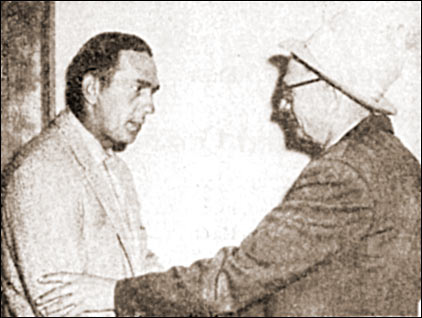
Karpinski (at left with club president Slim Thorpe) brought out the fans with his talent for stirring the pot. (See Edmonton Journal, August 14, 1956)
The big right-hander had a long pro career which included a 29-5, 1.56 season in the Florida State League in 1949 (he also was proficient with the bat, hitting .296 that season). That feat, among others, won him posthumous induction into the Florida State Hall of Fame in 2010. Karpinski, who also played basketball with the House of David, died in 1980 at the young age of 58.
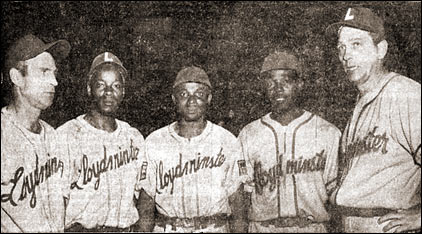
Top : The 1956 Lloydminster infield (left to right) : Eddie Morris, Benjamin Lott, James Valentine, Curly Williams with manager Stan Karpinski. (Edmonton Journal, July 3, 1956)
Karpinski and Morris were veteans of professional ball in the United States.
Lott, Valentine and Williams all had roots in Negro League play. Lott and Williams also had minor league experience.
Below : Meridians' second baseman Benny Lott in action at Sportsman's Park, Lloydminster.
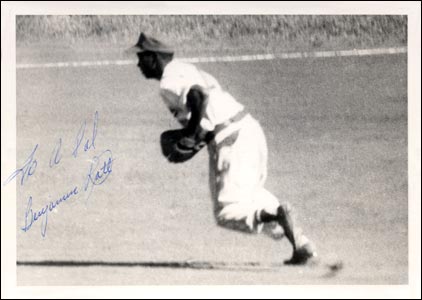
The managers and the ball parks (notice the distance to that left field fence at Abbot Field) : :
Saskatoon Gems, Ralph Mabee Cairns Field, seating 4,000, 380-440-275
Moose Jaw Mallards, Roy Taylor Exhibition Grounds, 4,500, 360-410-360
North Battleford Beavers, Emile Francis Abbott Field, 3,000, 285-375-290
Edmonton Eskimos, Wayne Tucker Renfrew Park, 6,200, 310-488-309
Regina Braves, Pete Beiden Taylor Field, 6,506, 320-420-340
Lloydminster Meridians, Stan Karpinski Sportsman's Park, 2,500, 360-385-334
In '56 at Lloydminster you guys needed a game, the last game of the season against us in your park and you needed it for the payroll but it had rained and the field was a mess. We're all there waiting and they poured more gasoline on that field ... gasoline on the infield and lit the match and then somebody in a car or a truck was going around in circles on the dirt to try and dry it out. And then some more gasoline. I'd never seen anything like that in my life. (Dale Zeigler, Edmonton)
The 1956 season included an interlocking schedule with the ManDak League, which by now had become all Dakota and no Manitoba (the early league had only one American team, Minot, in competition with the Winnipeg Buffaloes, Elmwood Giants, Carman Cardinals and Brandon Greys.
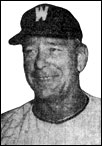
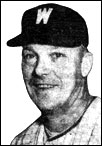 In '56 the Manitoba - Dakota loop featured the Minot Mallards, Bismarck Barons, Williston Oilers and Dickinson Packers. The American teams dominated, taking wins in 37 of the 46 games with WCBL clubs. The circuit, which featured such former major leaguers as Dee Moore (far left) and Roy Weatherly (left) would fold a year later.
In '56 the Manitoba - Dakota loop featured the Minot Mallards, Bismarck Barons, Williston Oilers and Dickinson Packers. The American teams dominated, taking wins in 37 of the 46 games with WCBL clubs. The circuit, which featured such former major leaguers as Dee Moore (far left) and Roy Weatherly (left) would fold a year later.
 Williston, which had finished first in the regular schedule, captured the league title downing Minot in the final playoff. The Mallards had won four straight ManDak championships.
Williston, which had finished first in the regular schedule, captured the league title downing Minot in the final playoff. The Mallards had won four straight ManDak championships.
Dolph Regelsky of Williston won the batting crown with a .362 average while Al Leap of Bismarck won the home run derby, with 23. Again, Sugar Cain of Minot and Preston Elkins of Williston were the top moundsmen. Cain finished with a 10-5 record and league-best, 2.29 ERA. Elkins was 15-4, 2.71. Elkins, who had the most wins, also led in strikeouts, with 110.
The official standings and statistics (neither those from Howe News Bureau nor the National Baseball Congress) were not entirely accurate. They missed a few games, and mixed up some people (Stan and John Karpinski). But, they're in the ballpark. Remember, this is the pre-PC (personal computer) era! The real final standings are up in the top right corner.
 In October, 1956 your 15-year-old statistician received a reply from Howe News Bureau in response to my claim that some of their stats were incorrect. The letter (with a 3-cent stamp) was signed by John F. O'Donnell :
In October, 1956 your 15-year-old statistician received a reply from Howe News Bureau in response to my claim that some of their stats were incorrect. The letter (with a 3-cent stamp) was signed by John F. O'Donnell :
"Thank you for informing us of our mistakes in the Western Canada League averages, here are the corrections as we have them. Add a win to Stan Karpinski's record making in 10-5, take a win away from John Karpinski, as a game in question was credited to him instead of Stan. Zayas and Satalich were credited with doubles instead of homers on the 1st. Take a double away from each of them and add a homer to each. Ben Lott's record is correct according to our figures, however on August 1 he was credited with four for five according to the Williston scorer. Sincerely, John O'Donnell, Howe News Bureau.
Among the year's outstanding achievements were two late season starts by Jackie Bowes of Saskatoon. Back-to-back one hitters! (In a third start, Bowes allowed five hits.)
Dale Zeigler of Edmonton had an incredible season. Two, two-hitters, two, three-hitters, a couple of five-hitters. The California kid won the ERA title. In 101 innings, he allowed just 68 hits and fanned 102. Control? Another story. 79 walks, 13 hit batsmen and 11 wild pitches. Mike Dayne (Dzingelowski) won 13 games.
However, the outstanding pitching performance likely came from wily veteran Stan Karpinski. Twice in the regular season he pitched both games of double-headers. On the 15th of July he tossed 18 brilliant innings as the Meridians took two from Regina -- a three-hit shutout in the opener and one earned run in the second game. He finished the season with a 10-5 mark and a 2.60 ERA.
The low point for the Meridians came on the 1st of August in a match up with Williston in one of the interlocking contests. The Oilers were awesome in crushing 28 hits in demolishing the home crew 22-3.
OFFICIAL WESTERN CANADA LEAGUE LEADERS (From Howe Sports Bureau)
For the second straight season, Cliff Pemberton of Saskatoon copped the Western Canada League individual batting championship with a mark of .349 in 66 games, according to official figures released by the Howe News Bureau of Chicago. Last season in 1955, Pemberton hit for a .360 average.
Phillip Oyler of Edmonton was runner-up with a .333 average in 47 games.
Pemberton topped the league in hits with 90, total bases with 138, and three-base hits with nine.
Robert Herron of North Battleford bashed out the most doubles, 18, and batted in the most runs, 60. Thomas Shollin of Edmonton hit the most home runs, 12.
Jose Valladares of Saskatoon scored the most runs, 58, and stole the most bases, 17.
Kenneth Guffey of Edmonton drew the most passes, 53, while at the other end of the scale, Buddy Burgess of Moose Jaw struck out the most times, 54. Norman Huletz of Regina was hit most often by a pitched ball, 10 times.
Jerry White of Regina produced the most sacrifice bunts, seven, while Robert Gerst of Edmonton and Edward Morris of Lloydminster tied for the honor of supplying the most sacrifice flies, four each.
Edmonton once again led the league in batting with a .278 average and led in most runs scored, 356. North Battleford topped the league in home runs with 44. North Battleford also won team fielding honors with a mark of .955. Edmonton turned in two triple plays, which is believed to be a league record, and led in double-play production with 66 twin killings.
Dale Zeigler, Edmonton left-hander, topped the pitchers in the ERA ratings with a mark of 2.32. He allowed 26 earned runs in 101 innings. Michael Dayne of North Battleford won the most games, 13, and started the most contests along with Ronald Watts of Moose Jaw, at 17 each.
Douglas Gostlin of Saskatoon pitched the most complete games,13. Thomas Garcia of North Battleford worked the most innings, 142, and faced the most batters, 542. James Stevens of Saskatoon struck out the most batsmen, 124, while Zeigler issued the most walks 79. Watts allowed the most hits, 145, Ben Reniker of Moose Jaw the most runs, 86, and North Battleford's Ben Griggs the most homers, 13.
The doormats of last season's wars, the Estevan Maple Leafs emerged as the 1956 champions of the Southern League. Evolving from the Coalers nickname of last year to that of the Maple Leafs this campaign, the Cinderella kids not only captured the regular season pennant with a two and a half game cushion over the defending champion Regina Red Sox but also stayed hot down the playoff trail by taking out the Reginans three games to one in the final series after bumping the Notre Dame Hounds in a semi-final matchup,

 Gary McKechney (left) of the rags-to-riches Estevan squad picked up the "Doc" Hughes Memorial trophy as the league's top pitcher by winning eight of nine mound decisions.
Gary McKechney (left) of the rags-to-riches Estevan squad picked up the "Doc" Hughes Memorial trophy as the league's top pitcher by winning eight of nine mound decisions.
Veteran Ed Heidt (right) of the other Regina entry, the Cardinals, led the league in hitting with a .435 average.
It was all Granum in Southern Alberta.
The White Sox topped the standings of the Foothills-Wheatbelt League during the regular schedule and downed Picture Butte in the playoff final. Granum won its third consecutive Alberta title beating Cold Lake in two straight 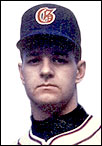 games as Willie Walasko (left) threw a no-hitter in the first game as the Sox won 4-0. Granum clobbered the Northern representatives 28-1 in the second contest. The White Sox also took home top prize money in three major tournaments -- Lethbridge, Calgary and Worland, Wyoming, and shared top money at Lacombe when the final was rained out.
games as Willie Walasko (left) threw a no-hitter in the first game as the Sox won 4-0. Granum clobbered the Northern representatives 28-1 in the second contest. The White Sox also took home top prize money in three major tournaments -- Lethbridge, Calgary and Worland, Wyoming, and shared top money at Lacombe when the final was rained out.
Walasko had one of the best-ever seasons by a pitcher on the prairies. The Alberta native won at least 20 games (full records are not yet available) while losing just two in league, 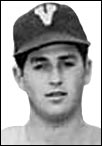 tournament and exhibition play. Included in his mound efforts were a no-hitter, a pair of one-hitters and a pair of two-hitters.
tournament and exhibition play. Included in his mound efforts were a no-hitter, a pair of one-hitters and a pair of two-hitters.
A young lefty from California, Pat Gillick (right), tossed a seven-inning no-hitter for Granum in the Medicine Hat tournament and followed that with a four-hit, seventeen strikeout performance to lead Granum to the title in the Calgary tournament. Gillick, from the University of Southern California, would go on to a brilliant front office career including a GM post with the Toronto Blue Jays in which the club won back-to-back World Series titles. In 2011, Gillick was inducted into the Hall of Fame in a special ceremony at Cooperstown.
Aloha. The Picture Butte Indians had a definite Hawaiian flair, via California's Coalinga College. Among the summer visitors were (left to right) Bobby Lee, Hans Pung, Dick Takamoto, Mako Tashima, Willie Yahiro and Larry Yogi.






At times there was a little friction between the imports and the hombrews. "There was a limited number number of girls in town", Greg Seastrom recalled. And, a few years later, there would be a campaign to use only local players.
Greg Seastrom : " A club owner who was pretty much responsible for starting the importing of players didn't want to stop. When he got voted down, it seemed he had bought home plate, so he went out and ripped it up saying, 'I don't want any bushers crossing my home plate.' Floyd Atkinson."
Pat Gillick has confirmed one of those wacky stories from the early days of the Foothills - Wheatbelt League.
"When Pat Gillick was playing for us (Vulcan) he didn't win a game ... but in the middle of the season George Wesley picks him up to go up north somewhere to play in a tournament and he throws a no-hitter. Well that didn't sit to well with the people of Vulcan. The next time he went to the bank (to collect his pay), before they gave him the money, they asked, 'Did Wesley pay you?' When Gillick said yes, they said, 'We're docking that from your pay' And they did." (Greg Seastrom, Gillick's Vulcan roommate)
While Gillick had trouble getting in the win column for Vulcan, he was money in the bank on the tournament trial. Pitching for Granum, he tossed a no-hitter to win a spot in the finals in the Medicine Hat tournament. Two weeks later, Gillick pitched a four-hitter and fanned seventeen to give Granum top prize in the Calgary tournament. And, at Fernie, he pitched Granum to an 18-1 victory and a spot in the finals.
" ... That's true! I was playing for the team in Vulcan, but played in those tournaments with George Wesley's team in Granum and basically they said if you're going to be playing with him you can draw half your salary from the Granum White Sox and half from the Vulcan Elks. My salary was $250 a month."
And, just how did Pat Gillick travel up to Alberta?
"Actually, I hitch-hiked from LA to Alberta. Well, money was tight in those times and I was trying to save a little money. I took about four days. I got into Salt Lake and went up to Idaho Falls and into Helena and Great Falls and up through that way and just kind of hitch-hiked along the way."
Are you sure you spell Granum, V-u-l-c-a-n? Jim Lester's introduction to Western Canada Baseball.
Sunday, June 3rd, 1956. Jim Lester, Greg Seastrom, Augie Scornaienchi and Billy Joe Davidson are still on the road in Billy Joe's two-door sedan. It's the opening day of the Foothills-Wheatbelt season. Vulcan (where Seastrom, Scornaienchi and Davidson are to play) and Granum (Lester's club) both are at home for opening day double-headers. In an effort to go non-stop from Visalia, California to Southern Alberta, the players rotate driving with the previous driver stretched out in the back with the other three in the front. They're already behind schedule when two breakdowns in Montana and a dispute at the border about the import of Louisville Sluggers ensures they won't see the first pitch of the season.
Tired, hungry and a bit disoriented, the four finally arrive in Vulcan. Obviously, the game is underway. Dozens of cars circled the field. "When they saw us there was hooting and hollering and honking and cheering. We thought we must be pretty important. It was like we were the President or something", said Lester. What they didn't know immediately was that Vulcan had already dropped the first game of the twin-bill 19-2 and was getting battered in the second contest and the fans wanted some new players, any players. Lester recalled, "Greg, Augie and Billy Joe went to suit up and when I was asked to play I told them I had signed to play with Granum and I didn't want to get into trouble. But, the man said he was the league commissioner and if he said it was okay, it was okay. So I ended up playing my first game in the league with Vulcan." The new blood helped to make the score in the second game more respectable, but Vulcan still lost, 14-7.
And, there was a little more to the story, as Greg Seastrom related, "There was the trip back to retrieve the car, which we lad left in Great Falls for repairs. On the return we got stuck in a giant mud hole in the unpaved road a few miles south of Vulcan. To get us out, we all had to get behind the car and push. Have you ever seen what one looks like after leaning into a car with its back wheels spinning in a mud hole? We were suitably baptized by the muddy earth of Western Canada."
Talk about changing times. For the amount of money the Texas Rangers pay shortstop Alex Rodriguez for ONE AT BAT, the Saskatoon Gems ran their entire operation for 1956. Gems ran a deficit of more than $6,000 on expenses of nearly $45,000. Lloydminster managed to survive on $29,000. See FINANCE
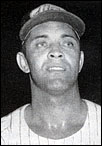

Two former Western Canada players were stars of the Global World Series held in Milwaukee. Wilmer Fields (left) and John Kennedy (right) help power the American squad (the Fort Wayne Allen Dairy team of Indiana) to the title defeating Hawaii in the final.
Fields, at first base and right field, batted .350. Kennedy, who would be the first black player to integrate the Philadelphia Phillies, hit .368. Both were named to the All-Star team.
Southern California had its usual bumper crop of prospects. Among those in the running for the top pro rookie from the Southland were a pair of former Western Canada moundsmen.
Ted Ellis (Coalinga). Pitcher for Lexington, Nebraska State League. Won 11, lost 1. Led league in percentage (.917) and had ERA of 1.74. Struck out 92 in 98 innings. Age 22, 6 feet 3 inches tall, weighs 180. Attended Coalinga High School and Fresno State. Signed for Boston Red Sox by Tom Downey.
Darrell Martin (Exeter). Pitcher with Portland, Pacific Coast League. Won 7, lost 2 and had 3.16 ERA. Played in highest classification league of any recommended. Age 21, 6 feet 2 inches tall, weighs 175. Attended Exeter High School and College of Sequoias. (Los Angeles Times, January 22, 1957)

